If your website neglects the incorporation of trust badges to instill confidence in new visitors, it is overlooking a substantial opportunity. In the following exploration, we will explore the imperative reasons your site should leverage trust badges. Subsequently, we will unravel 12 exemplifications of the most prevalent website badges, elucidating how they contribute to augmenting trust and elevating conversion rates.
But before delving into the array of trust badges, let’s establish a clear understanding of what precisely these trust badges are.
What Are Trust Badges?
Trust badges, alternatively termed “trust seals,” are diminutive icons or symbols strategically positioned on your website to signal to your audience that your website is not only reliable but also that their personal information is securely protected. While the nomenclature might not be immediately familiar, you have undoubtedly encountered these symbols on your preferred company websites.

These trust badges aren’t mere happenstance; reputable websites conscientiously display them to establish trust with new visitors. The mechanism is straightforward. As new visitors engage with your website, they lack prior interactions with your brand. In their eyes, your site might be perceived as just another potential eCommerce scam or spam platform aiming to exploit their trust for quick financial gain.
However, trust badges operate by borrowing authority from widely used and trusted websites, functioning as a smaller facet of employing social proof to fortify your business credibility. Surprisingly, these seemingly inconspicuous badges can be the determining factor between gaining or losing a new customer.
To comprehend their significance, let’s draw an analogy from the physical world. Imagine you are at home, engrossed in watching your favorite show on Netflix, and the doorbell rings. Peeking out, you observe an unfamiliar car in the driveway and an individual in casual attire at your entrance. Would you open the door or opt to stay concealed?
Now, consider a different scenario where, during your Netflix session, the doorbell rings again. This time, a police car is parked in your driveway, and a uniformed officer stands at the entrance. The official appearance, complete with a bright, shiny badge, catches your eye through the blinds. Would you be more inclined to open the door this time, or would you remain under the covers?
The analogy illustrates how trust badges on your website function similarly. Without them, your website may still attract visitors, but by proudly displaying trust badges, you significantly increase the likelihood of inspiring confidence in your visitors.
Why Digital Shoppers Are Skeptical About Your Site:
For eCommerce businesses, the utilization of trust badges is imperative, given the unique circumstances digital customers face when shopping online. Digital consumers are inherently more susceptible to fraud, and thus, they approach online transactions with a heightened level of skepticism—a skepticism that is entirely justified.
The eCommerce realm presents a distinctive situation where customers are required to divulge their credit card information for a product they haven’t physically encountered, tried, or seen. Additionally, for non-service online transactions, customers must pay upfront and then patiently await access to their purchase. This vulnerability creates a palpable sense of unease, making eCommerce customers more susceptible to fraud.
As a business owner or a representative of an eCommerce site, the burden falls on you to mitigate this skepticism and enhance the user experience through social proof. The responsibility is yours because your new visitors lack familiarity with your brand, and online fraud is a significant concern.
A study published by Finance Online in 2023 reveals alarming eCommerce fraud statistics, further accentuating the gravity of the situation. Consider these staggering findings:
1. The incidence of global payments fraud has tripled, soaring from $9.84 billion in 2011 to $32.39 billion in 2020. Projections estimate a continued upward trend, with an expected cost of $40.62 billion in 2027, representing a 25% increase from 2020.
2. eCommerce retailers face an average of approximately 206,000 web attacks every month.
3. 21% of consumers express fear of credit card data theft, and 19% harbor concerns about potential misuse of their personal data.
4. More than half of the surveyed consumers (54%) report experiencing fraudulent or suspicious online activities.
5. The United States is identified as the most fraud-prone country, with 34% of consumers stating they were most likely to have been victims of fraud.
These statistics underscore the prevalence and severity of online scams, illuminating why online consumers approach websites with caution. Consequently, it becomes crucial to explore avenues to assuage these fears and cultivate trust with new visitors.
### Overcoming Skepticism with Trust Badges
Multiple strategies exist to overcome the skepticism of online consumers and instill trust in your brand. Options range from acquiring customer testimonials and actively managing your digital reputation to addressing negative reviews. Notably, online reviews play a pivotal role in shaping purchase decisions, making it imperative to respond to and manage them effectively.
However, one direct and impactful approach involves the use of trust badges to build confidence in your new users. Trust badges play a significant role in allaying the apprehensions of your customers, allowing you to leverage the authority of well-known and highly trusted brands.
### How Trust Badges Increase Your Site’s Conversions
Trust badges serve as a powerful tool in assuaging your customers’ concerns and enhancing their confidence in your website. These badges facilitate you to borrow authority from other reputable brands, assuring users that their personal information is in safe hands. Moreover, trust badges have demonstrated a tangible impact on increasing conversions.
An illustrative study conducted by Blue Fountain Media provides compelling evidence of the impact of trust badges on conversions. In their study, they presented one form without a trust badge and another with a Verisign Secured trust badge. The results were staggering – the form with the trust badge led to an astonishing 42% increase in conversions.
Let that sink in. The addition of a trust badge resulted in a 42% surge in conversions. This is not an isolated incident; VeriSign, in a case study, revealed that their extended validation (EV) certificates led to a 30% increase in conversions for the hotel booking industry.
While the adoption of trust badges has become somewhat ubiquitous, their effectiveness in boosting conversions remains undeniable. In light of this, let’s shift our focus to explore 12 of the most common trust badges frequently encountered in action.
1. SSL Trust Badge:
SSL Trust Badges play a pivotal role in the intricate process of establishing and nurturing trust for websites. Within the domain of Google Chrome, users routinely encounter a discreet yet highly significant symbol—a small lock icon positioned adjacent to the URL. This unassuming visual cue serves as a powerful indicator, symbolizing the existence of an SSL certificate and providing users with the assurance of a secure connection. The sophistication of this feature is further elevated within the Google Chrome ecosystem, where users possess the capability to interact with the lock icon, unfurling a wealth of detailed SSL information.
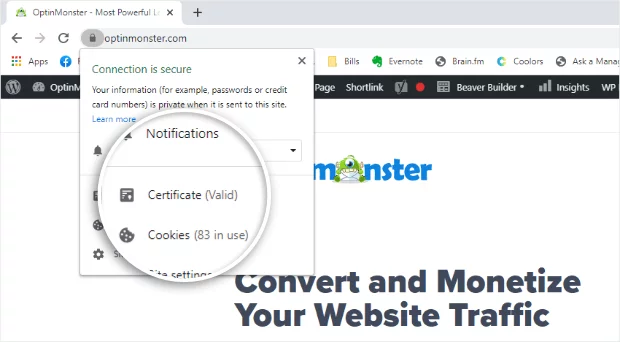
The activation and judicious utilization of an SSL certificate emerge as imperatives in the digital landscape, functioning as more than just a technical requirement. Instead, it becomes a strategic tool to effectively communicate and instill a heightened sense of security among site visitors. This meticulous approach is paramount in shaping the user’s perception of the website, fostering an environment where individuals confidently engage in online activities and are assured of the safeguarding measures in place.
2. Site Security Trust Badge
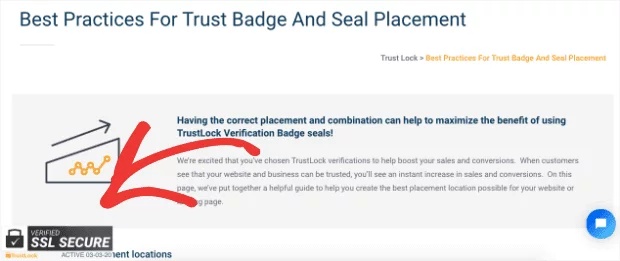
Transitioning beyond the foundational realm of SSL badges, certain forward-thinking companies opt for a more comprehensive strategy by integrating additional layers of security through prominently displayed Site Security Trust Badges on their home pages. An exemplary illustration is TrustLock, which strategically positions a discreet yet impactful logo in the bottom-left corner. This unobtrusive visual cue serves as a subtle but powerful assurance to website visitors that their sensitive information is enveloped within a robust shield of protection.
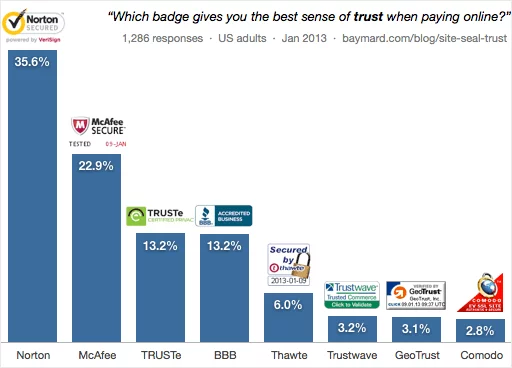
The landscape of trust dynamics within the digital sphere is intriguingly complex, with various entities vying for users’ confidence. A noteworthy insight into this realm emerged from a survey conducted by the Baymard Institute in 2013, where Norton’s security badge emerged as the most trusted. Although recognizing that this data may now be considered somewhat outdated, it underscores a timeless truth—the significance of trust in shaping online interactions. In essence, the choice and presentation of security badges become not only a technological consideration but also a strategic endeavor in building and maintaining trust within the ever-evolving digital landscape.
3. Money-back Guarantee

Money-Back Guarantee Trust Badges play a crucial role in the intricate process of fostering confidence and trust among visitors to websites. This particular type of trust badge, as exemplified by MonsterInsights, signifies a commitment to refund customers within a specified timeframe, often set at 14 or 30 days. Despite their unobtrusive size, these badges carry significant weight in shaping the overall perception of security, especially during those critical moments when users are contemplating transactions that involve sensitive information.
The incorporation of Money-Back Guarantee Trust Badges is not merely a technical requirement but a strategic move aimed at assuring users of a safety net should they be dissatisfied with their purchase. This transparent commitment to customer satisfaction contributes to the establishment of trust, reinforcing the notion that the website prioritizes the well-being and contentment of its visitors.
The nuanced nature of these trust badges becomes even more pronounced when considering the psychological aspect of online transactions. The mere presence of a visible symbol indicating a money-back guarantee creates a sense of reassurance and reliability, addressing potential concerns that users might harbor when navigating through the virtual realm of e-commerce.
4. Free Shipping
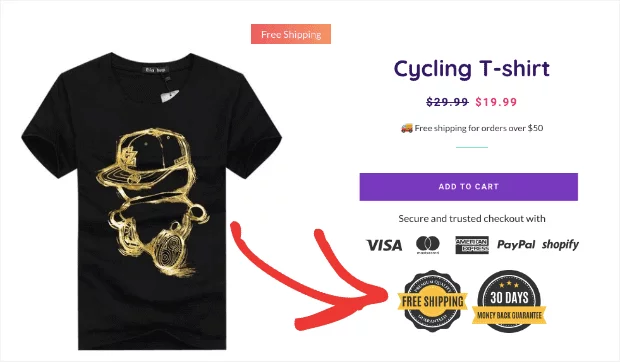
Free Shipping Trust Badges, on the other hand, emerge as a strategic tool employed by companies to not only reduce cart abandonment but also to actively encourage users to move forward in the checkout process. Illustrated through the use of a vibrant Shopify trust badge by a fashion e-commerce store, these badges extend beyond mere functionality. They serve as visual representations of the tangible benefit of free shipping, enticing users with the prospect of cost savings and a more favorable overall shopping experience.
The deliberate and thoughtful design of Free Shipping Trust Badges contributes to their conspicuous visibility. Bright colors and distinctive graphics are strategically chosen to ensure these badges stand out as users navigate their way towards the crucial final steps of the transaction process—the checkout page. This intentional placement and design aim to capture the attention of users, reinforcing the notion that the company values their satisfaction and is willing to provide added value through perks like free shipping.
5. Secure Payments Trust Badge
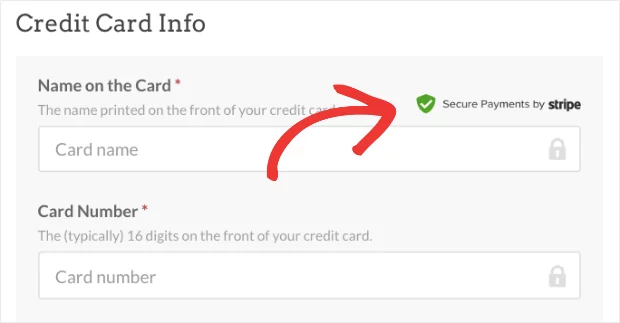
Delving into the online commerce, the significance of Secure Payment Trust Badges cannot be overstated. In navigating the landscape of digital transactions, where concerns about the security of sensitive information like credit card details loom large, businesses strategically incorporate these trust badges to instill confidence in their customers. WPForms provides a noteworthy example of this practice, employing a subtle yet impactful approach. Their trust badge takes the form of a simple yet reassuring green logo adorned with a small checkmark. Beyond its unassuming appearance, this badge serves as a visual anchor for customers, a constant reminder that their online shopping experience is fortified with robust security measures, assuring them of the safety of their financial transactions.
6. Accepted Payments Trust Badge

The classification of trust badges under the umbrella of “Accepted Payments” might spark debate, yet the undeniable value lies in the use of widely recognized logos such as Visa, Mastercard, or Amex. SEMrush’s pricing page serves as an illustrative canvas for this strategy. By incorporating these logos, the page not only aligns itself with established payment providers but also leverages the credibility associated with these recognized symbols. Despite the potential for misuse, the display of such logos offers customers an additional layer of confidence, providing tangible assurance in their purchasing decisions through association with reputable and acknowledged payment entities.
7. Industry Award Trust Badge

The incorporation of Industry Awards Trust Badges introduces a layer of prestige and credibility to a company’s online presence. Taking a cue from SEMrush’s strategy, these trust badges feature awards that extend beyond mere user trust. They signify official acknowledgment of excellence by industry critics, effectively contributing to the narrative of a website’s credibility. Even if the awarding entities may be unfamiliar to users, these badges play a crucial role in elevating the overall standing of a website, creating a compelling story of industry recognition and achievement that adds weight to the user’s perception.
8. Customer Logo Trust Badge
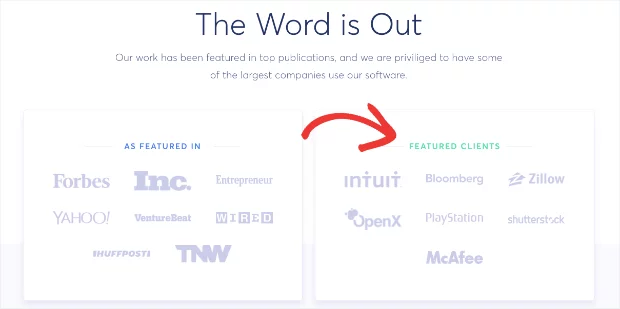
Customer Logo Trust Badges emerge as a strategic endeavor in the elaborate tapestry of enhancing a company’s trustworthiness. Displaying the logos of well-known clients, as exemplified by Awesome Motive, serves as a powerful endorsement that resonates with potential customers. The prominent showcasing of logos from brands like PlayStation, Zillow, and Shutterstock goes beyond mere validation of capabilities; it creates a visual narrative of inclusion and the fear of missing out (FOMO) among the audience. This practice contributes to the overall storyline of credibility and desirability, weaving a tapestry of trust that extends beyond the boundaries of financial transactions.
9. Total Satisfaction Trust Badge

Total Satisfaction Trust Badges, typified by the happiness guarantee exemplified by Bombas, transcend the conventional understanding of refund assurances. These badges symbolize a comprehensive commitment to supporting customers throughout their entire journey. They communicate that customer satisfaction is not just a checkbox on a list of services but a core priority. In essence, the Total Satisfaction Trust Badge becomes a tangible representation of the company’s dedication to exceeding customer expectations, elevating the trust-building process beyond mere financial transactions and into the realm of holistic customer care.
10. App Store Trust Badge

The inclusion of App Store Trust Badges in the repertoire of trust-building measures may not be conventionally perceived as a typical trust badge, but it unfolds as a clever strategy to showcase the availability of one’s software or service through reputable platforms. App store icons, such as those associated with Apple or Google, serve as subtle yet powerful indicators of legitimacy and reliability.
When users encounter these icons, often associated with downloading applications from esteemed platforms like Amazon or Apple, an inherent level of trust is implied. While acknowledging the existence of fraudulent products within these platforms, the predominant perception is that Apple, Amazon, and Google are inherently reputable. In essence, the display of App Store Trust Badges functions analogously to a traditional trust badge by leveraging the credibility of another company to bolster one’s own.
11. Free Trial Trust Badge
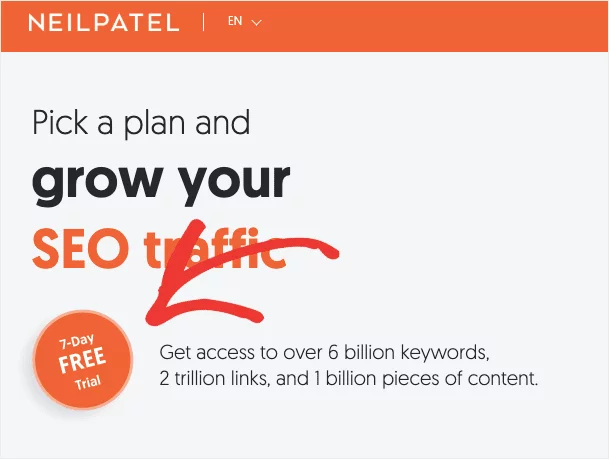
Free Trial Trust Badges represent a strategic divergence from the traditional money-back guarantee trust badge. By prominently displaying a badge indicating a free trial option, companies communicate to users that they can experience their product with zero financial risk. This bold value proposition holds the potential to entice even the most skeptical online shoppers, offering them a risk-free opportunity to explore the product or service.
An illustrative example from Neil Patel‘s website, UberSuggest, showcases the efficacy of the Free Trial Trust Badge. In a succinct yet impactful manner, the badge communicates to users that they can test the product before committing to a purchase. This not only addresses the user’s concerns about potential financial risks but also adds a layer of transparency and confidence in the company’s belief in the value of its offering. In essence, the Free Trial Trust Badge becomes a swift and efficient tool for showcasing the accessibility and quality of a product, fostering a risk-free exploration for potential customers.
Conclusion:
In online business, trust badges serve as invaluable assets, not only in retaining new visitors to your site but also in significantly boosting sales and reducing cart abandonment rates.
The effectiveness of trust badges lies in their reliance on social proof, a powerful psychological phenomenon that I have extensively discussed in previous writings—emphasizing the impact of authentic social proof, as opposed to deceptive practices.
However, trust badges are just one facet of leveraging social proof to enhance your business. Another notable method is through the implementation of positive action notification popups, a personal favorite in our toolkit. If you’ve been a follower of our blog or a frequent visitor to our site, you’ve likely encountered these notification popups, often appearing like the following:
“These small notification popups have been proven to increase overall sales by an impressive 15%!”
FAQs on Trust Badges:
Can trust badges be customized to match the branding of my website?
Absolutely! Trust badges can be customized to align with your brand’s color scheme, style, and overall aesthetics. This ensures a seamless integration with your website design, enhancing the overall user experience.
Do trust badges play a role in building long-term customer trust?
Yes, trust badges contribute significantly to building long-term customer trust. Consistent display of trust badges fosters a sense of reliability and security, encouraging repeat business and customer loyalty.
How can businesses test the effectiveness of their trust badges?
A/B testing is an effective method to gauge the impact of trust badges. By comparing conversion rates and user trust metrics with and without trust badges, businesses can optimize their badge selection for maximum effectiveness.



